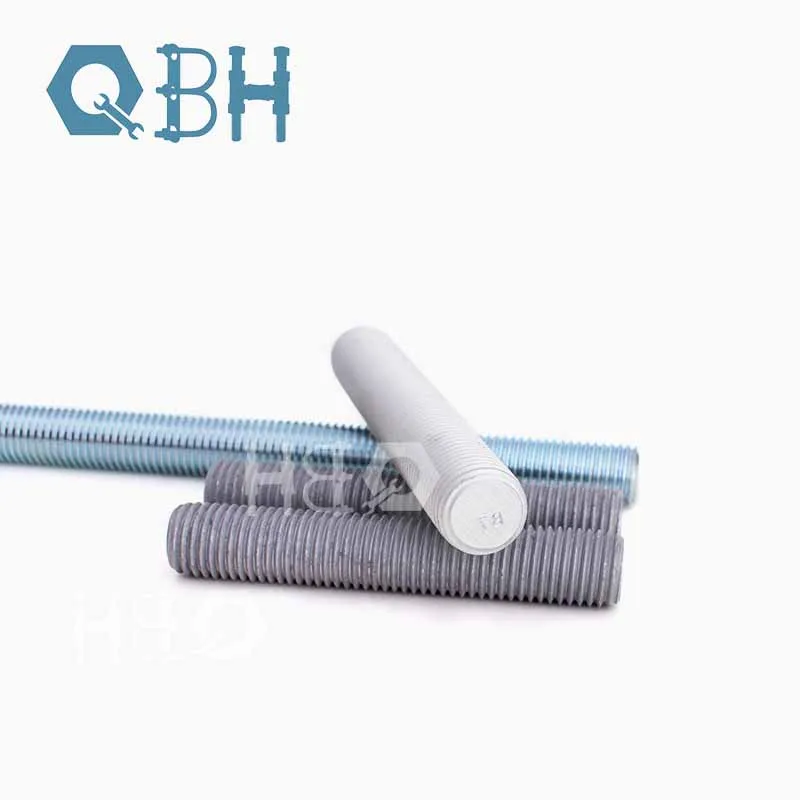What Is a Stud Bolt, and How Is It Used?
A stud bolt is a type of threaded fastener commonly used in industrial applications to join two parts together. Unlike traditional bolts that have a head on one end and threads on the other, a stud bolt is a straight rod that is fully or partially threaded along its length. It’s widely used in scenarios where high-strength, durable fastening is required, especially in environments that demand the use of flanged connections, such as in piping systems, machinery, and structural applications.

What Is a Stud Bolt?
A stud bolt is a cylindrical metal rod that has threading on both ends, or in some cases, it can be threaded along its entire length. The threaded ends allow nuts to be attached, which creates a strong clamping force when tightened. The stud bolt’s primary function is to hold two components together by creating a mechanical connection that can withstand significant force, pressure, or vibrations.
The absence of a head (like in traditional bolts) makes stud bolts useful in environments where space constraints, high strength, or specific installation needs make it difficult to use standard bolts.
Common Applications of Stud Bolts
Stud bolts are most commonly used in the following industries:
- Oil and Gas: In pipelines and refineries, stud bolts are used to secure flanges and pipe connections.
- Construction: They are used in structural applications where high-strength fastening is essential.
- Machinery: In heavy equipment and engines, stud bolts are used to hold large components together that require high torque and stability.
- Petrochemical: These bolts are used in pressure vessels, heat exchangers, and other equipment that operates under extreme conditions.
Key Features of Stud Bolts
Stud bolts are designed to provide strong, secure connections in a wide range of applications. Some of their key features include:
1. Threading on Both Ends
Unlike regular bolts, stud bolts have threads on both ends, which allow nuts to be tightened onto each end. This creates a stronger fastening connection, especially useful when working with flanges or other heavy-duty connections.
2. High Strength
Stud bolts are typically made from materials that offer high tensile strength and resistance to wear and corrosion, such as stainless steel, alloy steel, or carbon steel. This makes them ideal for industrial environments where the components they secure are subjected to heavy loads, high pressures, or harsh environmental conditions.
3. Versatility
Stud bolts come in a wide variety of sizes, lengths, and thread configurations to accommodate different types of connections. They can also be manufactured with different coatings to enhance their resistance to corrosion or environmental wear, such as zinc plating or galvanization.
4. Easy Maintenance
Because the stud bolt does not have a head like traditional bolts, it can be installed and removed without needing a specific orientation. This makes it easier to access and maintain, especially in tight spaces.
Types of Stud Bolts
Stud bolts can be categorized into different types based on their design and application:
1. Fully Threaded Stud Bolts
These bolts have threads along the entire length of the rod. They are commonly used in general-purpose applications where the nut can be adjusted to any point along the bolt.
2. Double-End Stud Bolts
Double-end stud bolts have threading on both ends, but the central part of the bolt is not threaded. These are often used when a specific distance or gap needs to be maintained between the two connected components.
3. Tap End Stud Bolts
Tap end bolts have threads on one end that screw into a tapped hole, while the other end has threads for attaching a nut. These bolts are commonly used in machinery and equipment assembly.
How Stud Bolts Are Installed
The installation process for stud bolts is straightforward, but proper tightening is essential to ensure that the connection is secure and will not fail under stress. The general steps include:
1. Positioning the Stud Bolt: The bolt is inserted into the threaded hole of one component or flange.
2. Tightening the First Nut: A nut is tightened onto one end of the stud bolt to secure it to the first component.
3. Aligning the Second Component: The second component is placed over the other end of the stud bolt.
4. Tightening the Second Nut: A second nut is tightened onto the other end of the stud bolt, ensuring that both components are securely fastened together.
5. Torque Application: To ensure the connection is strong enough to withstand the operating conditions, the nuts are typically tightened using a torque wrench to apply the proper amount of force.
Benefits of Using Stud Bolts
There are several advantages to using stud bolts over traditional bolts in industrial settings:
- Stronger and More Secure Connections: Since the studs provide a longer and more even distribution of clamping force, they are better suited for high-pressure or high-stress applications.
- Ease of Maintenance: With no bolt heads to contend with, stud bolts are easier to access and remove in confined spaces, making them more convenient for equipment maintenance.
- Customizable Length: The threaded ends allow for flexibility in the length of the bolt that can be adjusted with the nuts.
- Reduced Stress on Threads: In some applications, using stud bolts instead of bolts reduces stress on the threads, increasing the longevity of the connection.
In summary, a stud bolt is a threaded fastener designed for heavy-duty industrial applications where strength, durability, and reliability are critical. It is most commonly used in the oil and gas, construction, and machinery industries to securely fasten components that are exposed to high stress or pressure. With various types and configurations available, stud bolts offer flexibility and strength, making them essential for high-performance mechanical connections.
Jiaxing City Qunbang Hardware Co, Ltd. is a production/design/sales and after-sales as one of the fasteners business. Check out our website at https://www.qbhbolt.com for more information about our products. If you have any questions, feel free to contact us at sales@qbfastener.cn.




